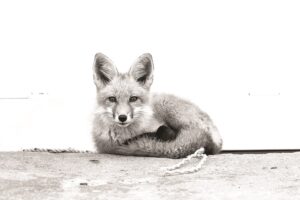I was driving up a sandy road on the ocean side the other day. I had been surfing in the early morning at a little sandbar. I was salty and calm with the heavy-body feel that comes from hours of exertion in the cold when I came upon a fox. He was sitting at the edge of the road, right near where I had seen baby foxes last April. His coat was a rich red-orange against the glossy winter-burned purple bearberry.
At this time of year, my eyes are always tuned to the edges of the road, watching to see what things are beginning to grow. Last year at this time, I remember seeing a cluster of little pointed spears of grass that had pushed up through the sand along here. Around it were the dusty gray leaves of artemisia, which would become full and thick when longer days arrived, and the drab sleeping olive green of winter pines. At the edge of the scrub oak woods, a movement caught my eye. Then I saw the three little fox kits rolling and tumbling on the bearberry.

As I drove nearer, the foxes went still, frozen in various mid-play poses. One sitting half up. Another on its side, legs sticking straight out. The third a prancing statue.
Adult foxes are sleek. Aside from their full tails, they are all tight angles and sharp features. The kits, though, are rounded, softer forms of their future selves. They’re puppy-like, with stubby noses, tiny paws, rounded upright ears tinged in fuzzy black. These had soft dashes of white on their chests and tail tips. Their movements were soft, too, still unsure. They were not yet taking the linear, clever steps they would grow into.
These pups’ parents must have built dens for them in January; the births come in March and April after only seven or eight weeks of gestation. The pups might have been six weeks old — halfway or so to being weaned. The dark fur of their legs faded from a deep black just above their paws to the sienna of their bodies. They made me think of kids who have just emerged from a swamp with mud stains up to their knees.
The kits looked right at me with shining eyes, focused and unafraid. We sat like this for a long moment, animals meeting. Looking into most animals’ eyes is akin to an assertion of dominance, and so a provocation. But in those smart and attentive eyes I saw curiosity.
As suddenly as they had stopped, the fox kits broke from their frozen poses and were in motion again. They wandered across the road in a line toward the ocean. There was no hurry in their movement. They clambered up the rise of bayberry and, before they disappeared into the brush, the last one stopped and looked back, again fixing those dark, intelligent eyes right on mine.
I had noticed before with foxes a kind of mutuality in our noticing of one another. They watch me as I watch them, still and silent near the chicken pen where they are studying the plump hens. When we notice one another, they do not sprint off. They seem to know how fast I can move and that I am not concerned with chasing them.
It struck me, though, that this was not something I had often experienced except with foxes. Making direct eye contact with another animal is something I have done almost exclusively with humans.
I have a fondness and admiration for foxes. They make me think of my older brother, Caleb — clever and playful, a trickster, but without any malice. And seeing the three foxes together in the free play of the very young reminded me of growing up as the middle brother of three. So much of our lives was spent in the delicate, essential learning of tackling and fighting and play in weed patches.
This year’s fox sat at the edge of the road, at ease in the warm morning sun. I stopped, giving him his space, and opened my window to see him better. He looked at me and gave a big morning yawn, unconcerned. After a long moment, he stood and moved up the hill with steps so precise they seemed practiced. At the edge of the dense oak and pine, he stopped and turned back, looking me directly in the eyes, before disappearing, light and silent into the brush.



